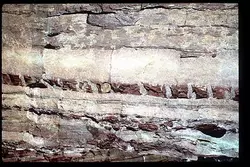Quiz
Test your knowledge of stratigraphic up indicators
Examine each photo by clicking on it to see an enlarged view. Then
answer two questions:
1. Which direction is the stratigraphic top?
2. What type of diagnostic feature is shown? (for example, cross
beds or mud cracks)
Once you have decided on your answers, click 'show the answer' to check
your answers.
1. The top of the bed is toward the top of the photo.
2. This is a stromatolite. They grow in a domed-upward shape which
allows sunlight to shine on the whole outer surface of the organism.
1. The top of the bed is toward the bottom of the photo.
2. These are mudcracks. Mudcracks create openings in the sediment that
are narrower toward the bottom. The red layer was the mud and the white
layer filled in the crack. You can see that the white filling is wider
at the bottom, showing that this sequence is upside down.
1. The top of the bed is toward the bottom of the photo.
2. This is a dropstone. Dropstones cut off the layers below them, while
the layers that are deposited on top of the dropstone will drape over
it. In this photo the layers below the dropstone appear to be draped
around the stone, indicating that the sequence is upside down.
1. The top of the bed is toward the bottom of the photo.
2. This is a cone in cone structure. Even if we don't understand how
they form, we do know that the pointy end points down, so this sequence
is upside down.
1. The top of the bed points away from the camera, and we are looking
at the bottom of the bed.
2. These are footprints. The bottom surface of a footprint is concave
when viewed from above and convex when viewed from below. This surface
is convex, meaning we are looking at the bottom of the bed.
1. The top of the bed is toward the bottom of the photo.
2. These are cross beds. Cross beds have a slightly curved "tail" that
is concave. The "tails" on these cross beds are convex, showing that
this sequence is upside down.
1. We are looking at the bottom of the bed.
2. These are sole marks. Sole marks are formed by water scouring out
areas of fine-grained sediment. The bottom surfaces of sole marks are
concave when viewed from above and convex when viewed from below. So in
this case the sole marks are convex and we are looking at the bottom of
the bed.








